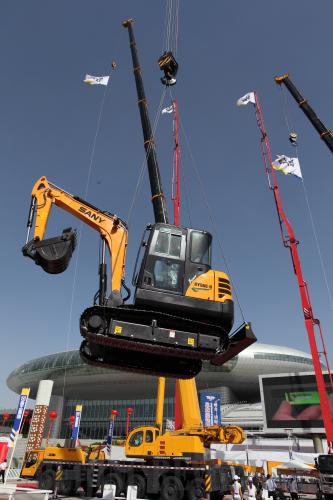|
 |
|
LIFTING HEAVY MACHINE: Pictured is the large machinery exhibition district of the second China-Euroasia Expo (SONG FAN) |
"Shipping still accounts for 95 percent of the China-Europe goods trade. In the next few years we hope to raise the proportion of overland freight transport to 10 percent," said Albertas Aruna, Secretary of the East-West Transport Corridor Association.
To date, most China-Europe overland freight has been carried on trucks. But this is changing as rail infrastructure in Xinjiang and China's central Asian neighbors rapidly improves.
The year 2008 saw the first test shuttle train depart from Beijing to Hamburg in Germany. The train, owned by German state-owned railway company Deutsche Bahn (DB), traveled along the Trans-Siberian arterial line through Mongolia. It arrived at its destination 10,000 km away in 20 days, twice as fast as the equivalent intermodal alternative based on shipping.
In 2011 DB changed tack and started employing the Xinjiang-Kazakhstan connection for its China-Europe overland freight. In April last year it initiated a Chongqing-Duisburg route, which passes through Xinjiang, Russia, Belarus and Poland. The first train, carrying laptops and LCD monitors, took 15 days to complete the 11,179 km journey. A regular Chongqing-Duisburg service kicked off shortly after, which now runs daily. Twice-daily departures are planned for 2013.
This year the Saule shuttle train has joined the DB train in providing a regular rail freight service from China to Europe. Run by VPA logistics, a Lithuanian company, the train departs from Chongqing for Europe's biggest port in Belgium's Antwerpen.
These "Silk Railroad" pioneers are inspiring, but there are still kinks to be ironed out if rail is to reach its full potential, said Ji Yuwei, head of the transportation department at the United Nations Economic and Social Commission for Asia and the Pacific.
"We need to simplify customs procedures further, come to a common agreement on taxes, charges and insurance, and introduce electronic tagging of wagons as de rigueur along the China-Europe route," Ji said.
A positive development was the completion of the SCO Road Transport Agreement in Beijing this year. But it could still be some time before it's ratified by SCO members and brought into force, he said.
At the China-Eurasia Expo, Chinese business representatives seemed cautiously optimistic about the prospects for this new Silk Road.
"Currently only 10 percent of our business is rail freight, most of which ends up in Central Asia," said You Zhengrong, Deputy Manager of Lianyungang Far-Famed International Freight Agency, based in Jiangsu Province.
"I suppose we would be interested in sending some goods to Europe by train," You said. "But we mostly deal in construction goods freight—time isn't a critical factor in transport. Shipping is slower, but it's cheaper. This new Silk Road sounds good, but at the end of the day it's all about cost."
The author is a writer at China Today
Email us at: yushujun@bjreview.com | 